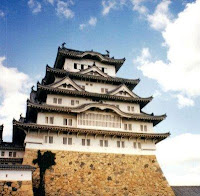Café Batavia, The Rendezvous...
 After going through the process of pushing to get into TransJakarta Bus, we drove towards the city, stop at the end of which we were riding the bus stop Ratu Plaza (Bundaran Senayan). From the halt, the passenger bus can not cross the arbitrary, trails regularly directed to the tail underground tunnel.
After going through the process of pushing to get into TransJakarta Bus, we drove towards the city, stop at the end of which we were riding the bus stop Ratu Plaza (Bundaran Senayan). From the halt, the passenger bus can not cross the arbitrary, trails regularly directed to the tail underground tunnel.This tunnel will lead to have 2 doors out of the station (the road towards the Mangga Dua) and west to the Museum Bank Mandiri. Although the underground tunnel is created, it is still this city streets around the station is jammed and is very solid.
According to the notes and narrative guide, the time of the tunnel excavation, the line of the old walls of ancient bricks were found. Presumably the remaining castle wall is the southern city limits of Batavia. The discovery of these ancient walls reinforce the notion that indeed the city of Batavia was the most southern boundary is limited to the city station. Areas further south towards the direction of the road of Gajah Mada and Hayam Wuruk is already outside the city area.
Areas outside the city became a kind of area of residence, even Villas with a large yard. Like the present moment, when we live in the suburbs of Jakarta, still can have lots large enough. An example is housing a very rich Chinese family at that time, namely Khauw families who have very large lots are now identified with the ancient buildings are still preserved, called Chandra Naya.
 In these plots built apartments and hotels, which reportedly planned Novotel Hotel and Apartments Star City. Unfortunately, this development looks choked up, though it was begun before 1998, until now has not seen signs of development to complete the structure that had been built which is left empty. Building where other luxury tingal is a Dutch family house now known as Archives Building (Gedung Arsip). Lots more wide-lots have become malls, hotels and other commercial buildings along the street of Gajah Mada and Hayam Wuruk.
In these plots built apartments and hotels, which reportedly planned Novotel Hotel and Apartments Star City. Unfortunately, this development looks choked up, though it was begun before 1998, until now has not seen signs of development to complete the structure that had been built which is left empty. Building where other luxury tingal is a Dutch family house now known as Archives Building (Gedung Arsip). Lots more wide-lots have become malls, hotels and other commercial buildings along the street of Gajah Mada and Hayam Wuruk. Once satisfied to see the ancient buildings of European style that most in miserable circumstances, we headed to an ancient buildings are preserved and quite antique in front of the museum's history, namely a café corner of the field, known as Café Batavia.
Once satisfied to see the ancient buildings of European style that most in miserable circumstances, we headed to an ancient buildings are preserved and quite antique in front of the museum's history, namely a café corner of the field, known as Café Batavia.From a poster plastered on the room Café, it is known that this building was founded in 1805. This building is the second building that was built after the Town Hall (Museum Fatahillah). In its history this building long enough to function as a residence, was once also a warehouse, as an office, art gallery and up to now as the Café.
The composition of European-style interior, with stairs and wooden floors. The walls decorated with photographs of black and white of old movie stars, politicians, historic figures, heroic figure et cetera. Until the toilet was also full of framed photographs.
 Varied menu with western style, Italian and Chinese food. Some frames from a series of photographs that hung, the back is a list of menus. When we sat down, took up positions alongside a window on the 2nd floor, a waiter took 2 frames and held out as a list of food menu and drinks list. In the café is also available magazines, and if you want to sit back and relax while dusk can choose a sofa or chair seat guests a more relaxed, by ordering snacks and drinks.
Varied menu with western style, Italian and Chinese food. Some frames from a series of photographs that hung, the back is a list of menus. When we sat down, took up positions alongside a window on the 2nd floor, a waiter took 2 frames and held out as a list of food menu and drinks list. In the café is also available magazines, and if you want to sit back and relax while dusk can choose a sofa or chair seat guests a more relaxed, by ordering snacks and drinks. As dusk approached, the panorama is exciting to be explored, until nightfall. For dinner options are also available at this Café. Enjoying a night on the ground Fatahillah also very exciting, because this park is designed to the night tour with a pretty interesting lighting. If you want to straighten legs, came back at Café Batavia because it is open till late at night.
As dusk approached, the panorama is exciting to be explored, until nightfall. For dinner options are also available at this Café. Enjoying a night on the ground Fatahillah also very exciting, because this park is designed to the night tour with a pretty interesting lighting. If you want to straighten legs, came back at Café Batavia because it is open till late at night.- Memories with My Son on September 2009
----------------------------------------------
(Story and written by aunt Prima Widi Hatmi/Photos Prima Widi Hatmi)


Comments
Post a Comment